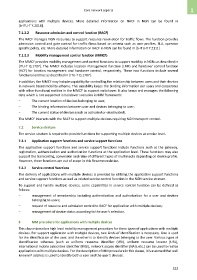Page 533 - 5G Basics - Core Network Aspects
P. 533
Core network aspects 1
applications with multiple devices. More detailed information on NACF in NGN can be found in
[b-ITU-T Y.2014].
7.1.2.2 Resource admission and control function (RACF)
The RACF manages NGN resources to support resource reservation for traffic flows. The function provides
admission control and gate control for traffic flows based on criteria such as user profiles, SLA, operator
specific policy, etc. More detailed information on RACF in NGN can be found in [b-ITU-T Y.2111].
7.1.2.3 Mobility management control function (MMCF)
The MMCF provides mobility management and control functions to support mobility in NGNs as described in
[ITU-T Q.1707]. The MMCF includes location management function (LMF) and handover control function
(HCF) for location management and handover control, respectively. These two functions include several
functional entities as described in [ITU-T Q.1707].
In addition, the MMCF may include capability for controlling the relationship between users and their devices
in network based mobility scheme. This capability keeps the binding information per users and cooperates
with other functional entities in the MMCF to support switchover. It also keeps and manages the following
data which is not supported in handover scenarios in MM framework:
− The current location of devices belonging to user;
− The binding information between user and devices belonging to user;
− The current status of devices (such as activated or deactivated).
The MMCF interacts with the RACF to support multiple devices requiring NGN transport control.
7.2 Service stratum
The service stratum is required to provide functions for supporting multiple devices at service level.
7.2.1 Application support functions and service support functions
The application support functions and service support functions include functions such as the gateway,
registration, authentication and authorization functions at the application level. These functions may also
support the transcoding, conversion and relay of different types of multimedia depending on device profile.
However, these functions are out of scope in this Recommendation.
7.2.2 Service control functions
The delivery of applications with multiple devices is provided by utilizing the application support functions
and service support functions as well as related service control function in the NGN service stratum.
To support and handle multiple devices, some capabilities in service control function can be defined as
follows:
− management of membership including authentication and authorization for a user and devices
belonging to users;
− request of resource and admission control to RACF for application with multiple devices;
− management of device status according to the user's selection.
8 MM procedure for applications with multiple devices
This clause describes high level mobility management procedure for three types of applications with multiple
devices. For support application with multiple devices, two kinds of identification is necessary. One is used
for the identification of the user, and the other is to identify devices belonging to the user. Various types of
identification schemes (such as uniform resource identifier (URI), uniform resource locator (URL),
international mobile subscriber identifier (IMSI), network access identifier (NAI), etc.) can be used to realize
applications with multiple devices. For the description of MM procedure in this clause, it is assumed that well
known IP address is used to identify both a user and the user's devices.
523

